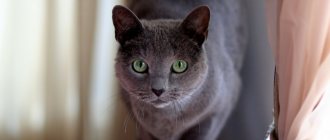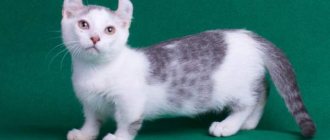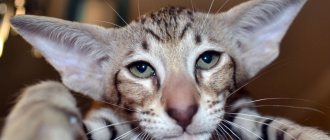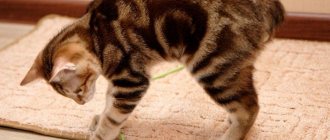The desire to keep a cat at home is understandable, but in practice many people are allergic to cat hair. It causes itching in the nasal passages, constant sneezing, and watery eyes. In severe cases, swelling of the airways may develop, which is life-threatening. It’s not worth risking your health, but you don’t have to give up your dream of owning a pet. For people prone to this sensitivity, hypoallergenic cats are ideal. A list of such breeds is presented in our article.
Hypoallergenic cats: review of breeds
Causes of allergies to cats
Many people blame cat hair for everything and think that it is the catalyst for an allergic reaction. But this is not true. Recent studies have shown that there is no direct relationship between the disease and the presence of fur in a pet. Intolerance in the human body is caused by a specific protein found in the saliva of animals. The substance was named Fel d 1, which is an abbreviation for Felis domesticus (translated as “domestic cats”).
An allergy to cats is manifested by sneezing, itching, lacrimation and other unpleasant symptoms.
Since all representatives of the cat family are distinguished by increased cleanliness, vigilantly monitor their fur and lick themselves with enviable consistency, saliva inevitably ends up on the animal’s skin and on its fur. Allergen particles are very small in size (3–4 microns), so they are easily transported by air currents and enter the respiratory tract. The protein is also found in the skin epithelium, urine and secretions of the sebaceous glands.
In this case, the length and thickness of the pet’s fur is not of fundamental importance; what is important is how much Fel d 1 protein is produced by its body. There are no cats that are completely deprived of this protein. But there are hypoallergenic breeds that produce this substance in much smaller quantities. The prefix “hypo” can be translated from Greek as “weak” or “less than.” An allergic reaction is possible, but it will be weak and not so pronounced.
It is generally accepted that allergies occur most often in cats with long hair.
From personal experience. The first time we came across allergies was when our eldest daughter fell ill. She coughed very badly for almost a year. All feather pillows, wool blankets and even all soft toys were removed from the house. The poor cat was locked up and hidden for a long time, but then he had to be given to good people.
Why do cats cause allergies?
Saliva, urine and other fluids produced by a cat contain proteins that cause allergies. By licking, the pet spreads the allergen throughout its fur coat, so some people have the misconception that it is the fur that causes allergy symptoms. In fact, the provocateur is a foreign protein that has entered the body, and not the wool itself. Often, a reaction occurs to industrial food or litter, so before looking for a new home for your pet, you should take blood tests to determine the allergen.
Useful video: which breed to choose
Given that there are quite a lot of cats that do not cause allergies, you should be guided by the characteristics of the breeds. Description and brief characteristics of cat species:
In addition, each cat has its own character. There are those who need affection and tactile contact with a person (Devon Rex, Sphynx), and there are those who require privacy and independence (Siamese, Balinese).
- When deciding to get a pet, it is important to take into account not only information about which cats do not cause allergies, but your own desire to care for a mustachioed friend, and the ability to keep the house clean.
- It is recommended to choose a breed that belongs to the category of hypoallorgenic (those animals in which the concentration of aggressive substances released into the air is the lowest).
There have been cases when allergy sufferers adopted a cat at their own risk, and the owner’s immune system adapted to their beloved animal, while other representatives of this cat breed caused an undesirable reaction in the allergy sufferer. Therefore, make a responsible choice and determine which cats do not cause allergies in you.
Mistakes when diagnosing allergies at home
If, after the appearance of a cat in the house, one of the household members has signs of conjunctivitis, dermatitis or rhinitis, before passing a verdict of “animal allergy”, it is necessary to carefully analyze the situation and make sure that there are no other causes for the appearance of these symptoms.
First of all, you should check whether your beloved pet has an invasive or infectious disease that can occur in both animals and humans. Thus, diseases such as toxoplasmosis, mycoplasmosis or chlamydia are often disguised as conjunctivitis and allergic rhinitis. Redness and itching of the skin can be caused by a mite infestation known as scabies, or a fungal infection known as lichen.
It is worth considering that in most cases the cat itself may not have external manifestations of the disease. Thus, an animal that has had chlamydia may not experience clinical manifestations of conjunctivitis in the form of minor discharge from the eyes, but at the same time the pet, being a carrier of the infection, can infect its owners.
The skin of many cats can be parasitized by a microscopic mite, Cheylithiella, which does not cause any problems for the animal. This parasite does not live on human skin, but once it gets on the skin, it can bite, which will lead to itching and irritation in that area.
Another common mistake when “home diagnosing” allergic reactions to a cat is incorrect identification of the allergen. So, it is likely that the cause of allergic disease is not the pets themselves. In modern times, people are increasingly faced with such phenomena as allergies to cat food, pet cosmetics, litter, toys and other accessories.
Hypoallergenic cat breeds
Contrary to popular belief, hypoallergenic cats do not have to be completely hairless . The list of such breeds also includes long-haired animals. It is believed that harmful protein accumulates in the undercoat, so its absence is the determining factor.
Rex
The Rex cat breed includes several varieties, but only two of them are considered hypoallergenic.
Devon Rex
The Devon Rex is an exotic breed of graceful cats that resemble creatures from another planet due to their huge erect ears. They have a large triangular head with pronounced cheekbones and short curled mustaches. A compact, powerful and muscular body with sculpted long legs makes the animals strong, active and extremely mobile. The coat of these cats is soft, sparse, short and wavy, without undercoat. Large golden or green eyes with a somewhat almond-shaped cut have a very meaningful and intelligent look that can melt the ice in the hardest heart.
Devon Rexes have a very meaningful, almost human look.
Devons are very mobile, playful and jumping, they love to occupy high positions on cabinets and shelves. They get along well with everyone who lives in the same territory with them. But they always choose an owner, whom they will follow on their heels, like a dog, and even wag their tail. They are able to capture his emotions and subtly sense changes in mood, express their attitude when communicating with various sounds (snorting, purring, trilling, purring, etc.). They can safely be called very smart and highly intelligent individuals.
Devons choose their only owner and do not leave him one step
Caring for Devon Rex is very easy, since the short and sparse coat does not require combing . For the same reason, these frozen cats need to be dressed for walks. They tolerate washing well, sometimes they can climb into the bath with their pet themselves. Males have no need to mark territory, and females do not make heart-rending sounds during estrus.
Cornish Rex
Tall, graceful and aristocratic Cornish Rexes are similar to Egyptian cats with an unusual elongated small head with a long nose and large ears that are wide at the base. The body is dry and medium-sized (no more than 3–5 kg) with well-developed muscles and high thin paws. Silky, delicate and short hair covers the entire body with curly dense waves, reminiscent of astrakhan fur. Eyelashes and mustache are also wavy.
The Cornish Rex has a soft, short and wavy coat.
The character of these cats is as aristocratic as their appearance. They will never do dirty tricks, steal food from the master's table, and, moreover, shit in places other than where they should be. The animals are very smart, easy to train, and become attached not to the house, but to the human owner. They are in extreme need of extra attention. You don’t just need to stroke and caress them, you need to talk to them.
In terms of intelligence, the Cornish Rex can be compared to a good service dog, since they understand everything themselves and never annoy their owners.
When you look at Cornish, you get the feeling that he knows and understands everything
Cornishes are completely non-aggressive, unvindictive and unforgiving, and love to play with small children. One can only envy their energy and activity. Cats of this breed also do not show parochial instincts and do not mark their territory. Aristocratic cats do not cause any difficulties in caring for them. The only caveat is that the claws do not retract completely into the small paw pads, so they need to be trimmed at least once a week. Bathe the animal approximately once every two months and clean the ears regularly.
Balinese cat
The closest relative of Siamese cats is the Balinese (Balinese) breed. But in terms of build, the Balinese are a little stockier and denser. The animal is medium in size, very elegant and slender, but at the same time with a well-developed muscular system. The head is triangular, wedge-shaped with a narrow lower jaw, the ears are large, almost regular triangular in shape. Bright blue narrow elongated almond-shaped eyes are located at an angle to the line of the nose. The paws are neat and long, the front ones are slightly shorter than the hind ones.
The Balinese cat is a relative of the Siamese and is very similar in color.
The coat is of medium length, there is no undercoat. The fur is soft, delicate and silky to the touch; it fits tightly to the body; the tail is fluffy with a pronounced fringe. Kittens are born completely white, but after six months their muzzle, paws and tail darken, giving them the characteristic Siamese coloring.
The character of these pets is not too soft, although they are far from Siamese cats. They love to play, so in order to avoid damage to interior items and furniture, it is necessary to provide Balinese dogs with special play equipment. They become very attached to their owners, they are smart, they are easy to train, but it is unlikely that they will be trained. In case of any offense, these cats cannot be scolded or physically punished, otherwise the pet may be seriously offended.
Balinese should not be punished because they may be very offended
Balinese are easy-going with children, but do not allow themselves to be bullied. If necessary, they can stand up for themselves. The relationship with Siamese cats makes itself felt.
The coat requires daily combing with a simple comb, the rest of the care is usual (cleaning ears and eyes, trimming nails, etc.). Periodically, the animal is bathed using a special pet shampoo to maintain a healthy shine to the coat. An important advantage of Balinese cats is that their coat does not mat and does not form tangles.
Sphinx
Among Sphynxes, there are two breeds that do not cause allergic reactions: Canadian and Don.
Canadian Sphynx
A striking representative of hairless cats is the Canadian Sphynx. The appearance of this animal is so original that it evokes very opposite feelings. Some are touched by the soft suede skin and large eyes, shaped like a lemon, with an intense, attentive gaze. Others consider huge splayed ears, as well as a large number of skin folds throughout the body, head and limbs, ugly and unsightly.
The appearance of the Canadian Sphynx is extremely unusual. Some people find it unsightly and scary.
Visually, the animal seems fragile and light, but this impression is very deceptive. Some Sphynx individuals can weigh up to 6 kg. The body is muscular, pear-shaped with a wide chest. The tail is thin and long, usually curled and pressed close to the body. The paws are high with elongated toes, sometimes slightly pubescent. There are no mustaches or eyebrows.
The character of the Canadian Sphynxes is not entirely cat-like. They probably feel almost human and therefore behave like full-fledged members of society. Curious and good-natured, these cats are absolutely devoid of aggression and are ready to endlessly endure the pestering of small children. They are completely conflict-free and get along with all the residents. They have a proud disposition, which is why they never beg or beg for food. The sphinxes will simply take it themselves (maybe straight from the dining table). The breed is distinguished by its mobility and jumping ability; they need to be provided with many shelves and stands on which to climb.
The Canadian Sphynx needs to be bathed often and its skin wiped with wet wipes.
Hairless cats sweat a lot, so they need to be wiped frequently with soft cloths so that the sweat does not dry out and also does not stain the furniture and clothes of the owners, whom the animals love to cuddle and climb into their laps.
There is a version that they have the gift of healing. Sphynxes have a slightly elevated body temperature (38 °C) and their heart beats twice as fast as that of other cats. Their metabolism is increased, pets of this breed are prone to obesity, so you need to approach the feeding process carefully. Cats are bathed approximately once every 3-4 weeks using baby detergents. Large ears need to be regularly cleaned of dirt.
Don Sphynx
Don Sphynxes are a Russian-bred breed. They differ from the Canadian ones in the almost complete absence of fur (small stubble of 2-3 cm is allowed) and fewer skin folds. These cats have large, oval, slightly slanted eyes and large, high ears, slightly tilted forward. The body is quite large (up to 5–7 kg), powerful and muscular. The tail is straight and long, but slightly rounded at the end.
The Don Sphynx has no hair at all
Don Sphynx kittens are most often born with their eyes already open.
These sphinxes show aggression extremely rarely; they love to play, but are lazy and prefer to just sleep most of the day. They are very loyal to other animals and do not even perceive mice as potential prey. They are easy to train and can be trained a little. They are distinguished by their sensitivity to their master’s mood, because they are especially affectionate when the owner is not feeling well.
Sphynxes need to be dressed, as they do not tolerate low temperatures well
The complete absence of fur obliges the owners to maintain the desired temperature in the room (at least 22–25 °C) or dress the pet in warm clothes, otherwise it will catch a cold. For the same reason, sphinxes need to be fed more often; they need a lot of energy to warm their own body. You should avoid direct sunlight on your skin, as then burns are inevitable.
From personal experience. One good friend had a Don Sphynx at home. This is a completely unusual animal; its body is always hot and slightly moist. The look is extremely meaningful and understanding. The children did whatever they wanted with him. The cat's claws were always cut very short, because he could severely scratch his own hairless skin. He physically couldn’t scratch the kids, and he didn’t even try. Only an extremely flexible sphinx could tolerate such manipulations with her own body. Often the mother had to save the cat when the children got too carried away. After being delivered, he hid in a secluded corner, but not for very long.
Siberian cat
The fluffy Siberian cat is also a hypoallergenic breed. This is a strong, large (up to 9 kg) animal with a large trapezoidal round head with high cheekbones on a powerful short neck. Siberians have medium ears, with small tufts at the ends. Green or yellow-golden large oval eyes are set quite widely. The limbs are muscular and strong, the paws are rounded, and fur grows between the pads.
The Siberian cat has luxurious thick fur
The coat is extremely thick with a long base pile and a soft double undercoat. The cervical collar and “pants” on the hind legs are clearly visible. It is difficult to bathe these cats, as their coat is waterproof due to its increased density.
Despite their increased hairiness, Siberian cats are recommended for allergy sufferers, since their saliva contains very little Fel d 1.
Siberian cats have a freedom-loving and independent disposition; they live their own lives and do not require increased attention from their owners. Smart, active and quick-witted pets will always find something to do. Having chosen their sole owner, they only tolerate the rest of the tenants and allow them to caress them. They behave very sensitively and affectionately towards their owner, but will not impose themselves under any circumstances.
Siberian cats have a warlike disposition and are not even afraid of dogs.
These cats are endowed with excellent guarding and protective qualities; they are not even afraid of dogs. But, possessing reasonable prudence, they themselves never go into conflict. Siberian cats are natural hunters; they are excellent at catching various rodents (rats, mice, gophers, etc.), so they love to go for walks.
Siberian cats are excellent hunters
From personal experience. Our previous cat was a typical representative of the Siberian breed with very long fluffy hair that is not prone to matting. He was an albino and therefore completely deaf. But his instincts took over, because he caught mice expertly.
Luxurious wool does not require any special care. These cats need to be combed at least once every 7-10 days. First, a sparse comb is used, then a more frequent one, and finally they go over the wool with a brush. During the molting period, you need to scratch more often. There is no need to carry out water procedures often; once a year will be enough. If your pet is free-range, it needs to be washed once every 3-4 months. The ears and eyes require regular care.
Oriental shorthair cat
Oriental cats are the closest relatives of the Siamese cat breed, but they differ in color because they do not have the characteristic dark areas on the tail, paws and face. The eastern type of appearance is manifested in a wedge-shaped elongated head with a narrow chin, as well as in slanting almond-shaped green (occasionally blue) large eyes. The ears of these animals are large, set quite low, and the line of the head continues with the line of the ears. The neck is long and graceful.
Orientals are related to Siamese cats, but have a uniform color throughout the body
The body of Oriental cats is relatively large (up to 8 kg), long, lean, muscular and graceful. The limbs are very slender, thin and long. The tail is shaped like a whip. The shiny, short, silky coat has no undercoat.
Orientals lack the aggression inherent in Siamese. They, on the contrary, are sociable and affectionate to the point of obsession. They do not tolerate loneliness well, so if your pet is often left at home alone, it is better to provide him with company in the form of a second animal. These cats become extremely attached to their owner, which often borders on addiction. Giving them to other people as adults is highly discouraged, as this will be a huge stress for the animal. They take a very long time to get used to it and can become depressed.
Oriental cats are characterized by increased talkativeness, which they show loudly on any occasion.
Orientals do not tolerate loneliness well, so it is better to take another pet of the same breed
Oriental cats are unable to sit in one place for a long time; they constantly need to run and play. They are well trained and can carry various objects in their teeth. These cats are hospitable and curious, never hiding when new people appear. They are extremely loyal to children and other pets and enjoy spending time with them.
Short hair does not require frequent brushing. At least once every 10–14 days, it is necessary to clean the ears and shorten the long nails. Animals need to be constantly trained; they understand all the intonations of the voice well. You cannot shout at them or punish them, since they are creatures with a delicate nervous organization. It’s enough to just say it loudly and sternly. Orientals love to go for walks, but this should only be done in warm weather (given the small coat) and only on a leash.
Javanese cat
Javanese cats are small in size and rarely weigh more than 5 kg. In terms of appearance, they are very similar to the Balinese breed, but differ in color. Their body is flexible, slender and long, their muscles are well developed. The head of cats is proportional to the size of the body, narrowing towards the chin. The bone structure of the skull is clearly visible to the touch. The profile of the muzzle is long and straight, without humps or depressions. Large ears continue the line of the wedge-shaped head. Almond-shaped eyes of a rich blue hue (less often yellow), medium size, slightly inclined towards the nose. The coat is soft and delicate, of medium length, with no undercoat. The hair on the tail is much longer.
The Javanese cat can come in a variety of colors.
The Javanese cat has a stubborn character; he wants to know everything, be on time everywhere and control everything . He chooses his favorite object (the owner) and vigilantly follows him, demanding constant attention. He does not tolerate loneliness well, he loves to socialize and “talk” (meow), although not as loudly as Orientals and Siamese. The animal is distinguished by its intelligence and intelligence, and loves to climb on top. This dexterous and strong animal must be given space to move and a sufficient number of toys, otherwise the home environment and order in the house will suffer. He can get along with other pets, but occasionally shows aggression.
Javanese have much longer tail hair.
The presence of a good multifunctional gaming complex in the house will allow the Javanese to throw out all their indomitable energy.
Caring for the Javanese consists of weekly brushing with a metal comb and regular cleaning of the ears and teeth .
They try to wash these cats as little as possible because they have dry skin. Water treatments are carried out as needed using special pet shampoos for cats with fine hair and conditioners. Animals love to walk, but this should only be done on a leash.
Which cats' fur does not cause disease?
The article describes in detail which cat breeds are not allergic and why. The fur of any cat does not cause an allergic reaction in humans. The main indicator of an animal’s allergy is the level of secreted substances that provoke the disease (protein substances or other microparticles), which are mostly contained in the salivary secretion, less often in the pet’s skin secretion, in its dandruff.
In addition, do not forget about the fate of the kitten, who will get used to the allergy sufferer and will have to change housing and owners. In addition to your health, it is important to remember that “we are responsible for those we have tamed.” Therefore, before bringing a kitten into your home, determine which cats you are not allergic to fur.
Which cats are suitable for asthmatics and allergy sufferers?
As already noted, when choosing a breed for sensitive people, you should base it not only on visual preferences, but also on other signs that may indicate hypoallergenic cats.
Read: Exacerbation of bronchial asthma
During the molting period, an allergy to wool can also occur in people who have not previously suffered from it.
Breeders recommend immediately paying attention to the animal’s fur. Thick hair and dense undercoat indicate that the cat will shed regularly. During this period, wool spreads throughout the apartment and constantly hovers in the air. It can trigger typical symptoms even in those who have not previously suffered from allergies.
Cat fur
A pet’s thin undercoat or lack thereof will make life easier for an allergy sufferer.
The best choice for an asthmatic or sensitive child is a pet with short hair without an undercoat or hairless cats. However, even in this case, you will need to follow the rules of care in order to reduce the risk of deterioration in your own well-being to a minimum.
Criteria for choosing a kitten of a hypoallergenic breed
The body of any representative of the cat tribe produces a protein that is dangerous for allergy sufferers. As a result of the studies, it turned out that in some cases the content of this substance will be less.
There are several factors that affect the concentration of Fel d 1 in the animal’s body:
- Floor. In females, the dangerous enzyme is released in smaller quantities. Castration surgery for males reduces protein production several times.
- Age. Before reaching puberty, the body of a small kitten practically does not emit a dangerous allergen.
- Breed. Some breeds genetically produce less of the problem substance.
- Wool coloring. A pet with a light coat is considered safer, since its body produces less protein compared to an animal with a darker coat.
Before you adopt a kitten, you need to know everything about its breed.
To choose the right hypoallergenic kitten, it is recommended to adhere to the following rules:
- You should buy an animal only from breeders in a nursery, only there the purity of the breed is guaranteed. Otherwise, the pet may not have the necessary hypoallergenic qualities.
- Allergy sufferers are advised to spend several hours with the mother cat before purchasing to make sure there is no negative reaction. You can ask the breeder to take the baby with the possibility of returning it if allergic symptoms appear.
- It is necessary to familiarize yourself in advance with all the features of keeping the desired cat breed.
- There is no need to follow fashion. You need to choose a kitten to your liking.
- When purchasing a cat, you need to immediately prepare for its future castration.
If you have a pronounced allergy, it is advised to opt for the Canadian Sphynx, because this breed is considered the least dangerous for people with hypersensitivity. The body of these cats practically does not produce dangerous protein.
To reduce the risk of a negative reaction, your pet must be carefully looked after. The skin needs to be washed and cleaned frequently with wet wipes.
To be a cat!
Many people, not wanting to give in to illness, decide to buy a kitten. To avoid disappointment, you need to act according to plan:
Since allergies cannot be cured, before purchasing a kitten you should tell the breeder that there is an allergy sufferer in the family. A conscientious breeder will agree to take the baby back in case of failure. This clause must be included in the sales contract; before going to the nursery, you need to consult a doctor, buy the recommended drug that blocks the attack, and be sure to take it with you; You need to spend at least a couple of hours in the nursery, petting the chosen baby, smelling its fur, playing; if signs of allergy have not appeared during this time, there is a chance of success. To make sure that the chosen kitten does not cause allergies, you need to take a sample of its fur or saliva. An allergist will tell you how to do this correctly. Laboratory tests will show how dangerous the protein contained in the sample is for an allergy sufferer.
Allergies to pets in children are a special case. It is important to explain to the child that the purchased kitten is staying in the house temporarily. If everything goes well, the pet will be able to stay; if not, the child, knowing in advance that the cat can move to another family, will worry less.
Allergies are a real scourge of developed countries and especially big cities. According to various sources, from 12 to 45% of people worldwide suffer from it. And one of the most common types is cat allergy. However, despite the plural number, this reaction applies only to some individuals, and not to the species as a whole.
And this is great news for those who really want to take home a cat, but are worried about allergies. Whether you were allergic to your previous cat or experienced unpleasant symptoms while visiting, there is no need to despair. In this article, the Murkosha shelter team shares the secrets of finding their ideal cat for allergy sufferers.
So, here are a few signs to help you make your choice.
Age. Kittens have less allergen than adult animals, but this is due to the fact that the baby’s body is not yet fully formed. A seemingly hypoallergenic kitten may unexpectedly provoke even a very strong reaction as it matures. Therefore, only an adult animal can guarantee the absence of a reaction.
Floor. Males produce more allergens than cats. The latter are preferable for allergy sufferers.
Hormonal background. Levels of potentially allergenic proteins are significantly higher in unspayed and unsterilized male cats. This is especially important for allergy sufferers, but is far from the only reason why sterilization of pets is important.
Read more: “Sterilization – why is it necessary”
Breed. Exotic, Scottish and British cats are considered the most allergenic due to their “stuffed” coat with a dense, thick undercoat, which is easily spread everywhere in large quantities. The most hypoallergenic are Sphynxes, Orientals, Abyssinians and, oddly enough, Siberian cats, as well as their mixed breeds (75% of allergy sufferers do not have a reaction to Siberians). Outbred cats do not have such a strict specification, so when choosing among them, you are not limited by the rigid boundaries of the breed, either in appearance or behavior.
Color. It has been experimentally revealed that white and light-colored cats are less likely to cause allergies. Genetics suggest that the concentration of the allergenic protein is related to the intensity of pigmentation.
At first glance, it may seem that it is cat hair that causes allergies. But in fact, it only contributes to the spread of the allergen. Therefore, there is no direct relationship between hair length and allergy in cats.
Fact: An allergy to cats may become less pronounced over time or even disappear if the immune system becomes accustomed to the constant presence of the allergen. This principle is the basis of a modern method of treating allergies - Allergen-specific immunotherapy (ASIT).
Allergists advise everyone, before getting a pet, to do allergy tests to determine whether you are allergic to the chosen animal. The Murkosha shelter offers a simple 3-step procedure for such verification.
1. You come to the shelter and choose the cats you like. It is best to opt for two or three to increase the chances of success based on the test results.
2. Shelter staff will take a skin scraping from the selected cats and give it to you.
3. With these samples you need to come to the laboratory and get tested for an allergic reaction.
Once you receive the test results, you can be sure whether a particular cat may cause an allergy in you.
Many people come to Murkosha with questions about allergies. We hope that this article will help everyone interested in finding answers and understanding that allergies are not an absolute contraindication for those who want to get a cat. We will be glad to see you among the guests of the shelter any day from 9 to 21 hours.
According to the World Health Organization, about 15% of the world's population suffers from cat allergy to one degree or another. How does this condition manifest itself, why does it occur, and what are the most effective methods to combat it? Let's figure it out.
Cats that are less dangerous for allergy sufferers
Veterinarians believe that there are no allergic cats at all.
If allergy symptoms are mild, you can choose a hypoallergenic cat. There are animals that emit small amounts of allergenic substances. It is necessary to organize proper care for such an animal; the owner should maintain personal hygiene and take antihistamines.
The following factors need to be taken into account:
- Cats are less allergenic than cats;
- Neutered cats are less allergenic than their non-neutered counterparts;
- Kittens emit fewer allergens, but you need to understand that they will grow over time;
- Light-colored cats are less allergenic than dark-colored cats;
- Since animals produce several allergens in different amounts, a person may have an allergic reaction to one cat, but not to another.
Cat and allergy sufferer in the same house
It is necessary to look for a new home for a cat if a person suffering from allergies is susceptible to bronchial spasms and swelling of the larynx - life-threatening symptoms that cannot tolerate compromise. When it comes to a runny nose and red eyes, you can try to create favorable conditions by minimizing the amount of allergen in the room:
once a week you need to bathe your pet and thoroughly comb its fur; change the filler immediately after use; the closed tray holds allergens, preventing their spread by air masses; If you install an air purifier in your apartment, allergies to cats will remind you less often. Ventilating the rooms daily also helps; clothes and bedding should be stored in sealed bags; instead of heavy curtains, it is better to hang curtains made of light fabrics; Be sure to wet clean the entire apartment twice a week using special products that neutralize the allergen; You should not let the cat into the bedroom and allow it to sleep on the clothes of an allergic person. Ideally, all clothing should be stored in plastic bags; It is better to remove the carpeting, replace upholstered furniture with leather; after interacting with a pet, a person suffering from allergies should wash their face and hands and rinse their mouth; Allergies occur less frequently if the pet is absolutely healthy. Any disease increases the amount of protein released. It is important to vaccinate your cat on time, treat it against parasites, and undergo a preventive examination by a veterinarian every six months; Cat care responsibilities should not be performed by a family member with allergies; Your pet should be spayed or neutered before puberty begins; At the first sign of deterioration, you should take prescribed medications. If symptoms are left unattended, reactions to the stimulus will intensify from attack to attack.
Interestingly, children who grow up in a home with a cat from infancy are less prone to allergies. Scientists believe that one pet reduces the likelihood of developing the disease from 20% to 10%. If there are two cats, the risk of allergies is reduced to 7%.
Reviews from owners of hypoallergenic cats
Allergy to skin particles, saliva and fur. There are no hypoallergenic animals. No dogs, no cats. I’m telling you as a dog breeder and an allergy sufferer rolled into one. Another thing is that for some unknown reason, some people are not allergic to some breeds. Need to try.
Bulldog
https://forums.drom.ru/zoo/t1152093587.html
My son has asthma; he was diagnosed at 4.5 years old. He was 10 when the Cornish Rex was adopted. The fur is short, 3 mm, there is no smell. He has been living with us for 10 years, everyone is happy, my son is not allergic to cats...
Natalia Pchelkina
https://deti.mail.ru/forum/dosug/bratja_nashi_menshie/gipoallergennaja_koshka/?page=8
My husband is allergic to cats, but I just adore cats)) And we want
Should I get a hypoallergenic cat... but I didn’t know which one... and then my sister showed me an article just about them... Now we have a Devon Rex cat Asya living at home... And my husband just adores her, just like me))
LolkaBalabolka
https://forum.mc-cats.ru/index.php?id=1101002
I am allergic, Sphynx cats cause allergies in me, just like any other cats. But I kept the Cornish with almost no problems, the cat even slept on my pillow, and I’m also an asthmatic. If you didn’t put your hands in your eyes and nose, it was normal, she squeezed calmly, this doesn’t happen with other breeds. And cats also cause me allergies that are much weaker than males. But everyone is different. Ask to visit the breeder, play with the kittens, and let your husband determine which breed is less allergenic for him.
archer
https://mama.tomsk.ru/forums/viewtopic.php?t=765426
I, my mother and my son are allergic, but only the mother reacts to the Sphynx (and while the cat was pregnant, the mother’s allergy disappeared; as soon as the kittens were born, the allergy appeared again). It's all individual. There are no universal solutions.
Ms.Fill
https://forum.mau.ru/viewtopic.php?t=18769&postdays=0&postorder=asc&start=0
My daughter is allergic to animal fur and dust.
But in September they still took a chance and adopted a bald cat. My daughter’s eyes used to swell up on animals, watery eyes, and a small rash appeared at the site of the swelling. There was no reaction to the eyes from the bald cat; at first, the places where the scratches were swollen and red (without itching), after a week this was no longer the case. So our cat has been with us for almost three months now and everyone is happy. The only thing is that my daughter’s room is still forbidden for cats to enter (a taboo zone) and we do wet cleaning there more often. And so she constantly squeezes her in her arms and kisses her, and cleans the toilet after her. True, you should always wash your hands afterwards, just in case.
Gaby
https://forum.ykt.ru/viewmsg.jsp?id=26522617
Interesting Facts
It has been proven that cats, compared to cats, spread significantly fewer allergens. Also, the younger the pet, the less irritants it produces. Spayed and neutered four-legged friends are less allergenic than full-fledged cats.
Studies have found that, regardless of breed and gender, allergic reactions to these pets of a dark pattern or color occur in people much more often than to light-colored cats. The allergenic properties of saliva, urine and skin of animals do not depend on the length of the coat and the breed.
Knowing how to cure allergies to cats and following the given recommendations for keeping a pet, you can get rid of unpleasant allergic manifestations without parting with your beloved four-legged friend.
Preventive measures
- castration or sterilization of an animal;
- regular bathing: when carrying out this procedure every other day, it is possible to remove almost 86% of all allergens secreted by the cat;
- Constantly cleaning the cat litter and using non-allergenic litter;
- regularly washing bedding and keeping cat toys clean;
- After petting an animal, you should wash your hands and completely avoid touching your eyes and face;
- regular wet cleaning of the entire room and thorough cleaning of carpets;
- Carrying out daily combing of dying fur hairs.
The occurrence of an allergic reaction
First, it’s worth understanding the causes of allergic reactions. Asthma is a chronic and virtually incurable disease that affects the airways. Allergies to pets with this diagnosis can manifest themselves in different ways, in mild and severe forms.
As a rule, upon contact with an animal, an allergic person’s breathing becomes difficult and continuous sneezing begins. In addition, the eyes become watery and red. Complications can even lead to impaired heart function and decreased blood pressure. There is a widespread belief that wool is the cause of an allergic reaction. This is not entirely true. According to researchers, there are several factors.
They contribute to the exacerbation of allergies to dogs and cats:
- saliva and epithelial particles;
- fungi on the skin of a pet;
- urine;
- dandruff;
- insects (dust mites).
Dogs and cats without hair and those that do not shed are considered anti-allergenic. However, they cannot be considered absolutely harmless. Before you even get a sphinx, you should “talk” with him for at least two to three hours. This is the simplest and most accurate way to test for sensitivity.
How does an allergy manifest itself?
Depending on the severity of the disease, individual characteristics and the amount of allergen entering the body, the following reactions are possible:
inflammation of the mucous membranes, sneezing, runny nose, stuffy nose; photosensitivity, lacrimation, conjunctivitis, red eyes; skin rash, often itchy, appearing in the area of contact with the allergen or throughout the body in a mirror pattern; difficulty breathing, wheezing, wheezing.
Signs of an allergy to pets are nonspecific. Similar symptoms appear with allergies to rodents, pollen, food, dyes and much more. There are cases where the disease subsides after several years of living next to a cat, but communication with other people's cats causes unpleasant symptoms. Apparently, the immune system “gets used” to the allergen of a particular cat and stops fighting it. However, if the patient has difficulty breathing, such experiments can only be performed under the constant supervision of a doctor.
The best breeds with a minimum of wool
Those cats that have no hair at all will also be hypoallergenic. These are the so-called hairless or hairless animals. Not everyone likes such breeds, but most of them are famous for their high intelligence and docile nature.
Canadian Sphynx
This is one of the first breeds of hairless cats to appear. If a person is prone to allergies, then it is worth choosing this one. Canadian Sphynx cats are not like other cats. Their peculiarity is the complete absence of standard wool. Instead, there is fluff, so the cat will feel velvety to the touch. The body of the animal is rounded, the skin forms many folds. Its shades can be different - plain or with spots. The “Canadians” have a long, whip-like tail, pointed at the end.
Canadian Sphynx
The animal's face also looks unusual. The Canadian Sphynx has large round eyes, clear cheekbones, and wide-set ears. There should be no whiskers, but whiskers are present above the eyebrows.
Despite their strict look, Canadian Sphynx cats easily get along with people
Canadian Sphynx cats are considered ideal pets for families with small children. These cats are affectionate and friendly. They don't get angry, don't hiss, and don't scratch. They are not characterized by aggressiveness. These are mobile and active animals that become attached to humans.
Don Sphynx
This is another option for cats without hair, and, unlike Canadians, these sphinxes may have no hair at all. To purchase a completely hairless cat, you need to pay attention to the type that the breeder will name. There are 4 of them in total, and they are discussed in more detail in the table.
Table. Types of Don Sphynxes
| Type | Description |
| Naked | There is no wool or fluff. The cat's skin is absolutely smooth. The epidermis feels like a rubber coating to the touch. |
| Flock | The animal's skin is covered with many short, straight hairs. They are soft and thin, almost invisible. Skin feels like a peach |
| Velours | The skin is covered with hairs 2-3 mm long. They are clearly visible to the naked eye. Hair may fall out, leaving the skin surface smooth |
| Brush | These cats have hair, but it is sparse, hard, crimped, and lies tightly to the body. |
The Don Sphynxes are visually different from the “Canadians” in that they have a more massive build, their skin has many more folds, and their ears are narrower and set higher. The eyes of the Don Sphynx are narrow, elongated, and have a stern look.
Don Sphynx kittens
The Don Sphynx is an excellent option for apartment living. This cat does not shed and does not smell. Cats practically do not mark their territory. These are smart cats that are litter trained without problems. They become attached to their owner, but can be touchy.
Peterbald
St. Petersburg sphinxes
There are also straight-haired varieties. Such kittens are born in the absence of the gene responsible for hairless skin. Outwardly, such cats resemble their closest relatives - Balinese or Javanese.
The Peterbald is a companion cat. This is a calm and kind animal that requires the company of other pets or people. These are unforgiving and non-aggressive cats.











